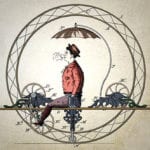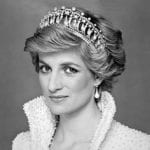 Creepy
Creepy  Creepy
Creepy  Technology
Technology 10 Scientific Breakthroughs of 2025 That’ll Change Everything
 Our World
Our World 10 Ways Icelandic Culture Makes Other Countries Look Boring
 Misconceptions
Misconceptions 10 Common Misconceptions About the Victorian Era
 Mysteries
Mysteries 10 Strange Unexplained Mysteries of 2025
 Miscellaneous
Miscellaneous 10 of History’s Most Bell-Ringing Finishing Moves
 History
History 10 Great Escapes That Ended Right Back in Captivity
 Weird Stuff
Weird Stuff 10 Fascinating Things You Might Not Know About Spiders
 Food
Food 10 Everyday Foods You Didn’t Know Were Invented by the U.S. Military
 History
History 10 Odd Things Colonial Americans Kept at Home
 Creepy
Creepy 10 More Representations of Death from Myth, Legend, and Folktale
 Technology
Technology 10 Scientific Breakthroughs of 2025 That’ll Change Everything
 Our World
Our World 10 Ways Icelandic Culture Makes Other Countries Look Boring
Who's Behind Listverse?

Jamie Frater
Head Editor
Jamie founded Listverse due to an insatiable desire to share fascinating, obscure, and bizarre facts. He has been a guest speaker on numerous national radio and television stations and is a five time published author.
More About Us Misconceptions
Misconceptions 10 Common Misconceptions About the Victorian Era
 Mysteries
Mysteries 10 Strange Unexplained Mysteries of 2025
 Miscellaneous
Miscellaneous 10 of History’s Most Bell-Ringing Finishing Moves
 History
History 10 Great Escapes That Ended Right Back in Captivity
 Weird Stuff
Weird Stuff 10 Fascinating Things You Might Not Know About Spiders
 Food
Food 10 Everyday Foods You Didn’t Know Were Invented by the U.S. Military
 History
History 10 Odd Things Colonial Americans Kept at Home
10 Musical Compositions That Are Completely Silent
Arguably the most important aspect of music is sound. The Oxford English Dictionary defines music as “the art or science of combining vocal or instrumental sounds to produce beauty of form, harmony… etc.” When people think of music, they may think of short, melodically pleasing pieces that comforted them in their childhood. They may think of grating, overplayed earworms that they constantly hear on the radio. They may even consider avant-garde, purposefully unmelodic experimentation as musical compositions.
But what happens when artists release or compose music that is completely silent? How is it possible to gain meaning from these pieces? To answer that question, here are ten silent musical compositions and why their silence gives them artistic or historical value.
Related: Top 10 Crazy And Unconventional Music Genres
10 John Cage, “4’33″”
Possibly the most famous silent composition, avant-garde composer John Cage created “4’33″” in 1952. Originally performed by David Tudor on August 29 of that year, the transitions between the three movements of the piece were marked by the opening and closing of a piano lid. The duration of the performance itself was marked with a stopwatch. To the surprise of no one, many were baffled that a piece of what was supposed to be melodic sound would be performed without, you know, sound.
However, Cage was serious about his intentions. After visiting Harvard’s anechoic chamber in 1950, he discovered that there was no true silence. As such, he decided to show his audience that the sounds they heard in everyday life were, in fact, music. As the composer explained, “Music is continuous. It is only we who turn away.”[1]
9 John Denver, “The Ballad of Richard Nixon”
Songwriter John Denver claimed that nuclear disarmament was a major goal of his. President Richard Nixon considered using nuclear weapons four times during his administration. Denver wanted to cut the defense budget. Nixon wanted to raise it. It’s safe to say that the two men had their fair share of political disagreements.
On his 1964 album Rhymes & Reasons, Denver expressed his opinions of Nixon’s administration twice. He composed a dig at Nixon’s vice president titled “The Ballad of Spiro Agnew,” of which the lyrics consist entirely of the words: I’ll sing you a song of Spiro Agnew and all the things he’s done. Denver didn’t bother thinking of anything good to say about Agnew, and his silent song dedicated to the President himself demonstrates that he bothered even less to think of good things about Nixon. Who knows what he would have done by the time Watergate rolled around?[2]
8 Soulfly, “9-11-01”
Now onto a more serious subject matter. The American metal band Soulfly released their album 3 on June 25, 2002, less than a year after the tragic terrorist attacks on September 11, 2001. Soulfly dedicated a minute of silence to those affected by the event on their first release since the attacks occurred.
Historically, the United States has commemorated the attacks with six moments of silence, all linked to the exact times that the four planes crashed across the country and the North and South Towers of the World Trade Center collapsed. This piece can be used as a method of mourning during those moments of silence and has hopefully motivated people to commemorate the moment of silence on their own terms.[3]
7 Vulfpeck, “Z”
There are ten Vulpeck songs eligible for this list, but this is the opening track of the album they all came from—Sleepify, an album of ten thirty-second snippets of complete silence. Here was Vulpeck’s plan—get users to stream the album, earn enough money from it to fund a tour, and allow admission to be completely free. Simple, right?
It turns out, yes! It took a month before Spotify took the album down, and they even responded in the meantime, calling the work “derivative of John Cage.” All in all, the band made $20,000 from streams and was able to fund the Sleepify Tour. Not bad for an album they called “the most silent album ever recorded.”[4]
6 Taylor Swift, “Track 3”
At this point, there’s no way a household name like Taylor Swift won’t break charting records. When she released Folklore, only having announced the album the day before its release, the physical edition sold over 1.3 million copies, and the digital edition broke streaming records on Spotify, Apple Music, and Amazon Music. It should be no surprise, then, that anything that Swift releases will be talked about—even when that release is a complete glitch.
In October 2014, days before the release of her synth-pop album 1989, iTunes released a song simply titled “Track 3.” Eager Swifties purchased the song only to discover…it was composed solely of eight seconds of silence. Despite this, it shot to No. 1 on iTunes in Canada before eventually being taken down. It just goes to show that excited fans will take whatever they can get their hands on.[5]
5 Brett Black, “Silence–5 Seconds”
Once again, this is the opening track of a completely silent album—Brett Black’s Silent Tracks of Various Useful Lengths. The album is described as the first commercially available album of silence. Black claims he created the album after waking up one morning and hearing a “catchy” piece of silent music repeating in his head.
He cited John Cage and French mime Marcel Marceau as inspirations, saying he wanted to “take silence to new levels” with the album. He hopes that someday, Coldplay will be interested in performing the compositions.[6]
4 John Lennon, “Nutopian International Anthem”
Threatened with deportation from the United States after a marijuana charge, beloved Beatle John Lennon and his wife Yoko Ono held a press conference on April 1, 1973, to announce the birth of a brand new nation. This conceptual nation, Nutopia, had no boundaries or laws, only people.
As ambassadors of the nation, they asked for diplomatic immunity and recognition from the United Nations, giving 1 White Street in Tribeca as their address. On his 1973 album Mind Games, John Lennon included a five-second silent track titled the “Nutopian International Anthem,” demonstrating his true intent to have only people in his civilization. So, what, no music, either?[7]
3 Yves Klein, “Monotone-Silence Symphony”
This entry is slightly cheating because Yves Klein’s symphonic piece does not contain complete silence. It opens with a single D major chord played for 20 minutes straight and then transitions into a 20-minute period of silence.
Klein conceptualized this piece in the 1940s, claiming that this expressed what he wished his own life to be. In 1960, in the only documented performance of the symphony during Klein’s lifetime, ten musicians participated in performing the piece. Over five decades later, in 2013, a New York performance of the piece consisted of 70 musicians and singers bringing this conception of Klein’s wishes to life. If only he could see his work now.[8]
2 Raymond Scott, “Silent Music”
In 1941, Time Magazine reported on a 13-piece orchestra that performed a piece that its audience found rather strange. The brass and woodwind instruments mimed playing, the pianist softly pressed the keys, but hardly any sound came from the stage. To bandleader Raymond Scott, this was silent music.
It is still unknown why Scott decided to perform this silent piece. However, philosopher of music Julian Dodd claims that it could have been either an ironic comment on effort and failure or intended for comedic effect. Regardless, audience members were confused during the performance. They giggled, finding the performance amusing. According to the writer for Time, “it was just provocative enough to make listeners wonder whether the silence of other bands might sound better than Scott’s. Yikes.[9]
1 Stiff Records, The Wit and Wisdom of Ronald Reagan
Closing out today’s list of silent musical compositions is another politically charged release. Clearly, someone had a beef against President Ronald Reagan, much like John Denver’s beef with Richard Nixon. The Wit and Wisdom of Ronald Reagan was not a song but a completely silent album released by Stiff Records.
The record contained grooves where you could play it, but it included no music. According to the BBC, it was intended as “an ironic alternative to more traditional protest songs.” Despite the silence of the album, the release was evidently somewhat popular as it sold over 30,000 copies during its release. It really is crazy what people will buy sometimes.[10]








